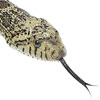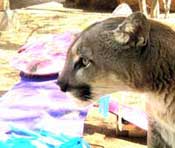
BY CLIFF FAVER, DVM | APRIL 13, 2011
Be ready for rattlesnake season
 One of the most threatening and feared dangers in the desert is the rattlesnake. Bites are typically more frequent in spring and fall, but can occur throughout the entire year.
One of the most threatening and feared dangers in the desert is the rattlesnake. Bites are typically more frequent in spring and fall, but can occur throughout the entire year.
Snakes attempt to avoid confrontation whenever possible, but if a dog should push its luck or become too curious, snakes are never afraid to take care of business. The bites generally are not fatal if treated quickly and appropriately; however, the aftermath of the venom can cause significant discomfort and tissue damage.
In our pets these bites are commonly inflicted on the tongue which causes severe swelling and potential suffocation or to the face and body where toxins are quickly absorbed into the blood stream. The necrotoxin has been found to cause the capillary blood vessels to break down, causing severe bleeding into the tissues. The toxin also commonly affects the ability of the blood to clot. Both of these factors add to the shocky condition of the patient. With this in mind taking the time trying the unproven methods of “cut and suck” the wounds, icing it, putting on a tourniquet or utilizing home remedies are not only contradicted but are also counterproductive. Any decrease of blood supply to these areas can actually worsen the prognosis.
When a pet is bitten by a snake it should be taken immediately to a veterinarian for treatment. Treatment is based on aggressive fluid therapy, monitoring for blood changes, antibiotics, and treatment with antivenin. Antivenin is the most important aspect because it will neutralize the toxin preventing further damage to the tissues and minimizing blood loss. Animal Health Services 24/7 Pet Urgent Care Center keeps a supply of antivenin for rattlesnake bite emergencies. In fact, during an antivenin shortage, Animal Health Services was asked to assist in trials on developing a rattlesnake antivenin to allow mass-production in the United States.
Encounters with our local wildlife may be unavoidable; however, there are preventive measures pet owners should take to help keep their family members safe. Rattlesnake avoidance training is fast becoming the prevention effort of choice. Having your dog snake-trained can keep a potentially dangerous situation from happening. In fact, on walks, snake-trained pets have been known to alert their owners that a rattlesnake is near thus protecting both pet and owner.
While there is a rattlesnake vaccine on the market for dogs, when requested, there was no research documentation provided by the manufacturer to prove its effectiveness and their own literature recommends antivenin if the dog is bitten.
For more information on rattlesnake bites and pictures and snake training visit www.ahsvet.com and click on the “Bite Club” button.
APRIL 13, 2011
Southwest Wildlife Conservation Center's Spring Enrichment Party
 Southwest Wildlife Conservation Center's Spring Enrichment Party on Saturday, April 2 was a day filled with fun for the kids, adults and animals. Human guests made treats with fruit, nuts, mealworms, "mousicles," and more for the SWCC permanent residents to open and enjoy. Some folks glued hair trimmed from horses and a donkey that live on the property to a cardboard deer, which Tocho the mountain lion enjoyed tackling.
Southwest Wildlife Conservation Center's Spring Enrichment Party on Saturday, April 2 was a day filled with fun for the kids, adults and animals. Human guests made treats with fruit, nuts, mealworms, "mousicles," and more for the SWCC permanent residents to open and enjoy. Some folks glued hair trimmed from horses and a donkey that live on the property to a cardboard deer, which Tocho the mountain lion enjoyed tackling.





 Would you love to own a beautiful Arabian colt with championship blood lines? Or would you like the chance to win some cash? TRRFCC Horsemanship has just the raffle for you. This Arabian colt, “Star Bright” nicknamed by a student from Horseshoe Trails Elementary School, has been donated to us and now you have the opportunity to make him part of your family. Tickets are $20 each or 3 for $50. The winner will be drawn at the annual Hoedown for Horseshoe Trails Elementary School on April 21, 2011.
Would you love to own a beautiful Arabian colt with championship blood lines? Or would you like the chance to win some cash? TRRFCC Horsemanship has just the raffle for you. This Arabian colt, “Star Bright” nicknamed by a student from Horseshoe Trails Elementary School, has been donated to us and now you have the opportunity to make him part of your family. Tickets are $20 each or 3 for $50. The winner will be drawn at the annual Hoedown for Horseshoe Trails Elementary School on April 21, 2011.